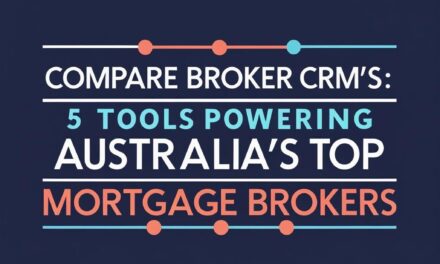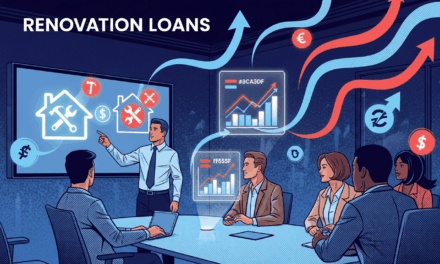The AI-Powered Brokerage: 5 Practical AI Tools to Reclaim 10 Hours a Week
The Australian mortgage broking industry is at a pivotal juncture, defined by the dual forces of unprecedented market dominance and acute operational pressure. This article provides a comprehensive strategic analysis of the rapid integration of Artificial Intelligence (AI) into this landscape. While the industry aggressively adopts AI to drive operational efficiency, it confronts a profound consumer trust deficit, with a mere 6% of Australians willing to entrust AI with mortgage research. This central tension shapes the technology’s deployment not as a replacement for human brokers, but as an indispensable “co-pilot” designed to augment their capabilities.
In This Article
Section 1: The New Competitive Arena: The Australian Mortgage Broking Landscape in an Era of AI
Market Context and Digital Pressures
The adoption of Artificial Intelligence within the Australian mortgage broking sector is not occurring in a vacuum; it is a direct response to a unique confluence of market forces that have simultaneously empowered and strained the industry. The foundational context is the unequivocal dominance of the mortgage broker channel. According to the latest data from the Mortgage & Finance Association of Australia (MFAA), brokers now originate a record 74.1% of all new residential home loans. This figure represents a significant 14.7 percentage point increase since the introduction of the mortgage broker Best Interests Duty in 2021, underscoring the deep-seated consumer trust in brokers to navigate an increasingly complex lending market.
However, this market leadership has been accompanied by intense operational pressures. A survey highlighted by the MFAA reveals that 51% of young brokers identify time and workload management as their most pressing professional challenge. This is compounded by the immense burden of staying current with dynamic legal and compliance changes, a concern for 44% of brokers, and the perpetual need for effective lead generation and marketing, cited by 42%. These acute pain points—time scarcity, compliance complexity, and business development demands—create a highly receptive environment for technological solutions that promise efficiency, automation, and scale.
The Rise of the AI Co-pilot
The strategic narrative surrounding AI in mortgage broking is not one of automation rendering humans obsolete. Instead, the prevailing and most pragmatic model is the integration of an “AI co-pilot,” a suite of intelligent tools designed to augment and enhance the capabilities of the human broker. Industry leaders have articulated this vision clearly, with Lendi Group, for instance, framing AI as a “copilot framework that helps brokers be better at what they do”. This philosophy is echoed throughout the industry, where the consensus is that AI is not there to replace the broker, but to enhance the value a broker provides.
The core value proposition of the AI co-pilot is the strategic reallocation of a broker’s most valuable resource: time. By automating mundane, repetitive, and time-consuming tasks, AI liberates brokers to concentrate on the high-value, uniquely human aspects of their profession. These automatable tasks span the entire workflow, from generating marketing content and transcribing client meetings to extracting data from financial documents and performing initial compliance checks.
Consumer Sentiment vs. Industry Adoption: A Critical Disconnect
Despite the industry’s clear trajectory towards AI integration, a formidable barrier remains: a stark and critical chasm between professional enthusiasm and public skepticism. A recent Consumer Pulse survey by Agile Market Intelligence delivered a striking verdict on consumer trust. When asked how they would research their loan options, a mere 6% of Australian consumers stated they would be comfortable using an AI-powered digital assistant, even if it could automate the entire process from comparison to application and management.
Key Takeaway: The consumer trust gap dictates that the most successful AI strategies will be those that are effectively “invisible” to the end client. The winning value proposition is not “our AI will find you the best loan,” but rather, “our expert broker, augmented by the market’s most powerful technology, will find you the best loan.”
Section 2: Deconstruction of the Broker-Centric AI Ecosystem
The AI landscape serving Australian mortgage brokers is not a monolithic entity but a rapidly diversifying ecosystem of tools and platforms. These technologies can be categorized into distinct but overlapping layers.
The All-in-One AI Platform: BrokerBuddie.ai Case Study
A prime example of a comprehensive AI platform is BrokerBuddie.ai, which positions itself as an all-in-one AI platform built specifically for Australian finance brokers. Its core value proposition is to save brokers hours each week by using AI assistants trained on real lender policies to handle tasks from content and compliance to client communications. The platform is structured around a suite of specialized “Buddies,” including assistants for residential, commercial, asset finance, compliance, and marketing.
The Integrated Hub: Workflow Automation Platforms (Effi Case Study)
Another key category is the integrated hub, which combines CRM, workflow automation, and AI features. A leading player is Effi, which positions itself as “the modern broker’s secret weapon.” Its core purpose is to automate the administrative and communication-heavy aspects of a broker’s workflow, employing an AI-powered matching algorithm to intelligently assign new leads and learning from a broker’s behaviour to suggest automated responses.
| Dimension | BrokerBuddie.ai | Effi |
|---|---|---|
| Primary Function | All-in-One AI Platform (Policy, Compliance, Content) | Integrated CRM & Workflow Automation |
| Target User | Mortgage Broker / Brokerage | Mortgage Broker / Brokerage |
| Key AI-Driven Features | Specialized “Buddies” for loan policies, compliance, marketing; Content Studio with pre-built prompts. | AI-driven lead matching, automated client comms, behavioral learning. |
| Stated Value Prop. | Save hours with AI assistants trained on real lender policies. | Reduce admin by 50% to double settlements. |
The Specialist’s Toolkit: Task-Specific Augmentation
Beyond integrated platforms, brokers are adopting a diverse ecosystem of AI tools to solve discrete problems.
- Conversational Intelligence (AI Scribes): Tools like Otter.ai and Fireflies.ai automatically record, transcribe, and summarize client meetings, creating an invaluable record for compliance.
- Generative AI for Marketing: Large Language Models like ChatGPT are being embraced to draft social media posts, blog articles, and client emails, saving hours of manual effort.
- Intelligent Document Processing (IDP): Platforms like DocVu.ai and Ocrolus use AI to automate the extraction of key data from financial documents, drastically reducing manual entry and errors.
- Personalised Video Marketing: The next wave of engagement involves AI-powered video platforms like Vidyard, which can generate personalized video messages at scale based on CRM triggers.
Section 3: The Compliance Tightrope: AI and the Best Interests Duty
The Best Interests Duty (BID): A Primer on Broker Obligations
Introduced after the Royal Commission, the Best Interests Duty (BID) legally obligates brokers to act in the best interests of their clients. Critically, this legislation is principles-based and does not include a “safe harbour” provision, meaning brokers must actively determine how to meet their obligations and produce evidence demonstrating they have done so.
AI as a Compliance Multiplier
When deployed thoughtfully, AI tools can be powerful allies in meeting BID obligations. AI scribes create verbatim, time-stamped transcripts of every client meeting, forming an unparalleled audit trail. Policy-checking tools can create a clear record showing that a wide range of options were considered. This creates a “Compliance Multiplier” effect, where a single action (a recorded meeting) generates multiple, robust compliance assets.
AI as a Compliance Risk
Despite its benefits, the indiscriminate use of AI introduces significant risks. The most acute is data privacy. Using third-party AI tools, particularly those based overseas, creates challenges under Australian privacy law. The class-action lawsuit filed against Otter.ai in the US serves as a critical cautionary tale, alleging unauthorized interception of conversations and use of data for model training without consent. Furthermore, the broker remains 100% accountable for any advice given, even if based on an AI’s inaccurate “hallucination”.
Key Point: Accountability is absolute and cannot be delegated to a machine. Brokers must establish a formal, written AI usage policy with a mandatory “human-in-the-loop” protocol. This requires brokers to personally review, verify, and approve all substantive AI-generated outputs before they are finalized.
Section 4: Strategic Outlook and Recommendations
The Future Broker: Augmentation, Not Replacement
The evidence overwhelmingly suggests that AI will not make mortgage brokers redundant. The deep-seated consumer preference for human interaction in high-stakes financial decisions provides a durable competitive moat. Instead, AI will act as a powerful catalyst for the evolution of the broker’s role. As administrative and procedural tasks are absorbed by the “AI co-pilot,” the broker’s value will shift decisively toward skills that machines cannot replicate: sophisticated strategic advice, deep market knowledge for negotiation, and high-level emotional intelligence.
Winning Strategies for Industry Stakeholders
For Mortgage Brokers:
- Adopt Strategically, Not Indiscriminately: Begin by identifying acute operational pain points and implement targeted solutions to demonstrate a clear return on investment.
- Prioritize Compliance Above All: Treat every AI adoption decision as a compliance decision first. Conduct thorough due diligence on vendors, obtain explicit client consent, and maintain rigorous human oversight.
- Invest in Uniquely Human Skills: Proactively invest in professional development focused on complex lending scenarios, negotiation tactics, and strategic financial planning.
For Aggregators and Lenders:
- Curate and Vet Technology: Aggregators must take a leading role in vetting and approving “RegTech” partners whose solutions are pre-vetted for compliance with BID and Australian privacy law.
- Provide Frameworks and Training: Develop and disseminate clear AI usage policies, best-practice guides, and comprehensive training modules for broker networks.
For FinTech Developers:
- Build for Compliance First: The most sustainable market opportunity is not to build a “smarter” AI, but a “safer” one. Design solutions from the ground up with the requirements of BID and Australian privacy law in mind.
- Solve the Integration Problem: The next wave of value creation will come from platforms that successfully unify the current fragmented toolkit into a seamless interface.
Conclusion: From Practitioner to Architect
The journey forward is not about more hustle. It is a strategic transformation from being a broker who does all the work to a business owner who builds the system that does the work. This requires a fundamental shift in mindset. Your goal is no longer to be the best practitioner; it is to be the best architect. By focusing on building a system that leverages AI safely and effectively, you solve the industry’s biggest challenges, avoid its most common traps, and create a valuable, scalable asset for the future.
Get More Insights





